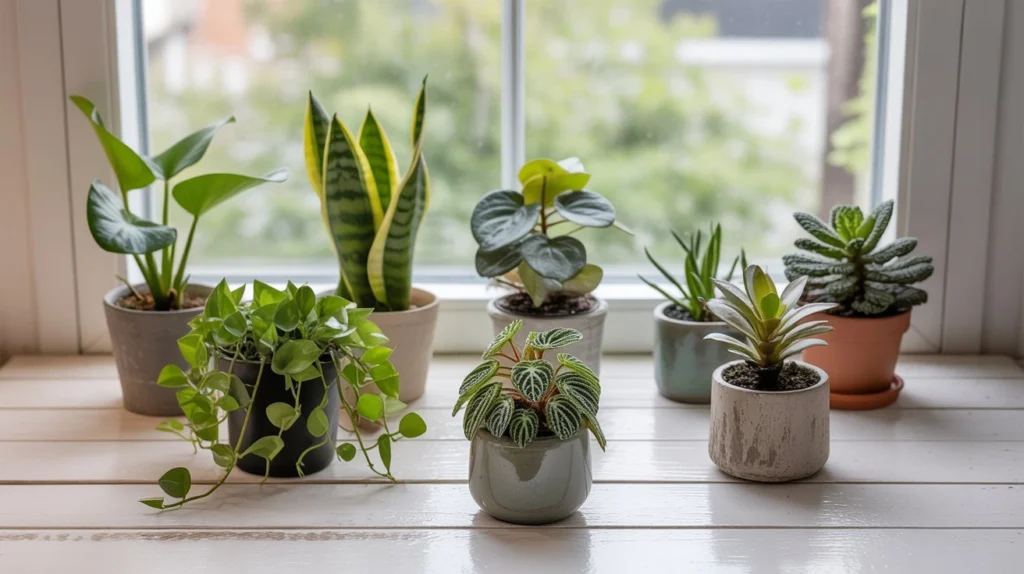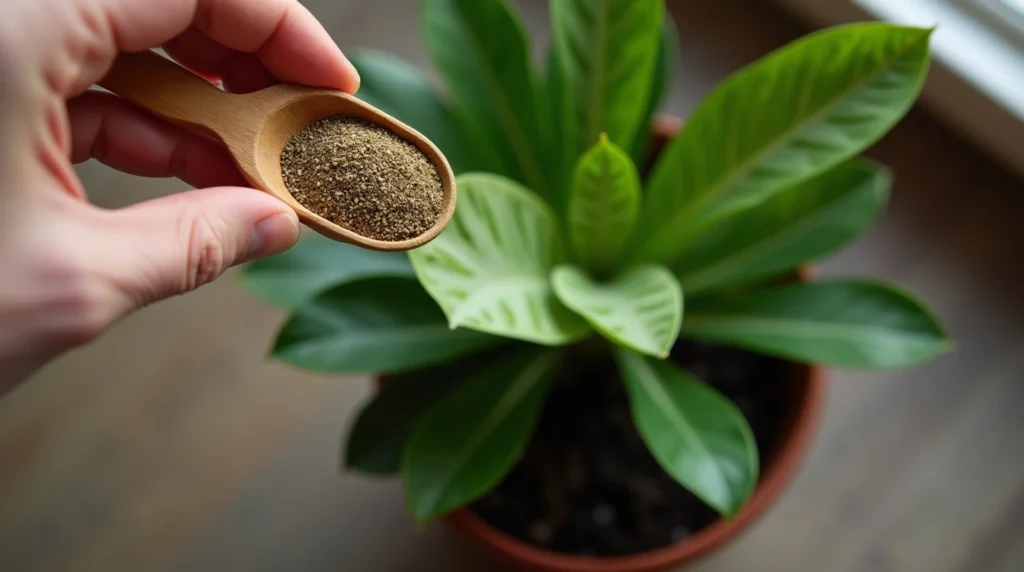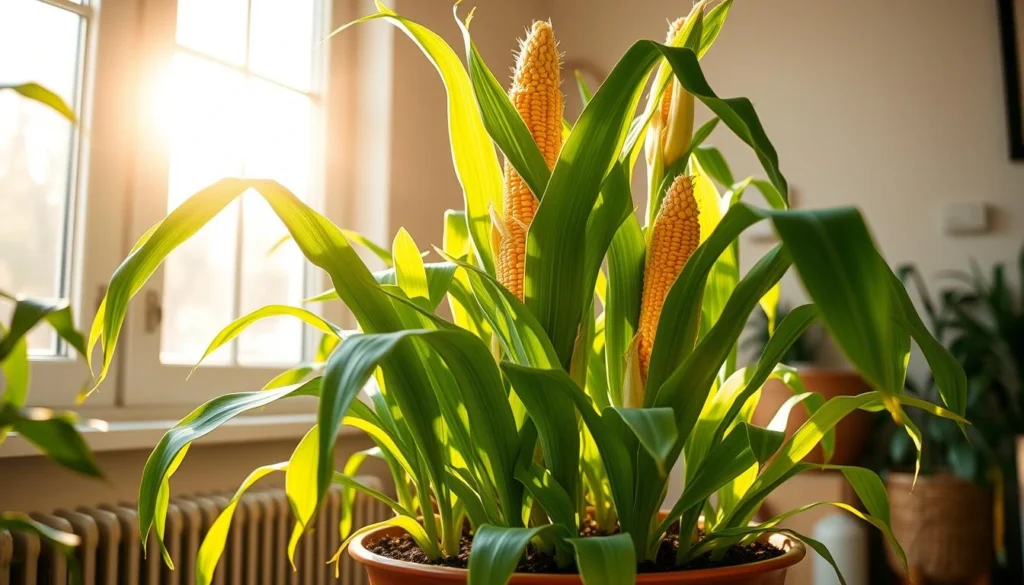
Want to add some green to your home? Think about growing a corn plant indoor. This tropical tree is easy to care for, looks great, and makes an excellent low-maintenance houseplant.
Having a corn plant indoor is rewarding. It can grow up to 6 feet tall, adding height and beauty to your space with its lush green leaves.
With a few simple steps, your corn plant will thrive indoors. This article will show you how to care for it and enjoy its timeless charm.
Table of Contents
Getting to Know the Corn Plant (Dracaena fragrans)
The corn plant, known as Dracaena fragrans, is loved by many indoor gardeners. It’s both versatile and beautiful, making any room look better.
Origin and Natural Habitat
The corn plant comes from tropical Africa. It loves humid, warm places. This makes it a great choice for homes around the world.
Popular Varieties for Indoor Growing
There are many varieties to choose from. ‘Massangeana‘ has yellow-striped leaves, ‘Lindenii‘ grows big, and ‘Victoria‘ has unique leaf patterns. These options let gardeners pick the look they like best.
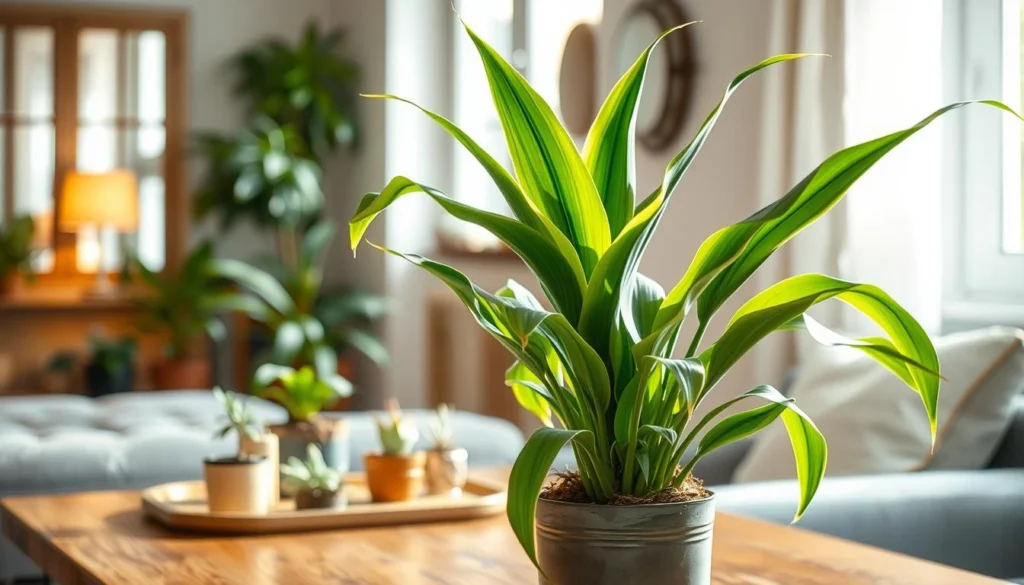
Benefits of Having Corn Plants in Your Home
Corn plants can make your home better in many ways. They can lift your mood, spark creativity, and lower stress. They’re not just pretty; they also help keep the air clean. For the best care, make sure they get enough light and water.
- Improves air quality
- Enhances aesthetic appeal
- Promotes well-being
Creating the Ideal Environment for Your Corn Plant Indoor
Indoor corn plants need a special environment. They need the right light, temperature, and soil. To decorate with corn plant indoors well, you must understand these needs. By mimicking their natural habitat, your corn plant will flourish.
Light Requirements and Placement
Corn plants love bright, indirect light. Direct sunlight can burn their leaves. So, place them near a window with filtered sunlight.
East- or west-facing windows are perfect. They give the right light without harsh rays.
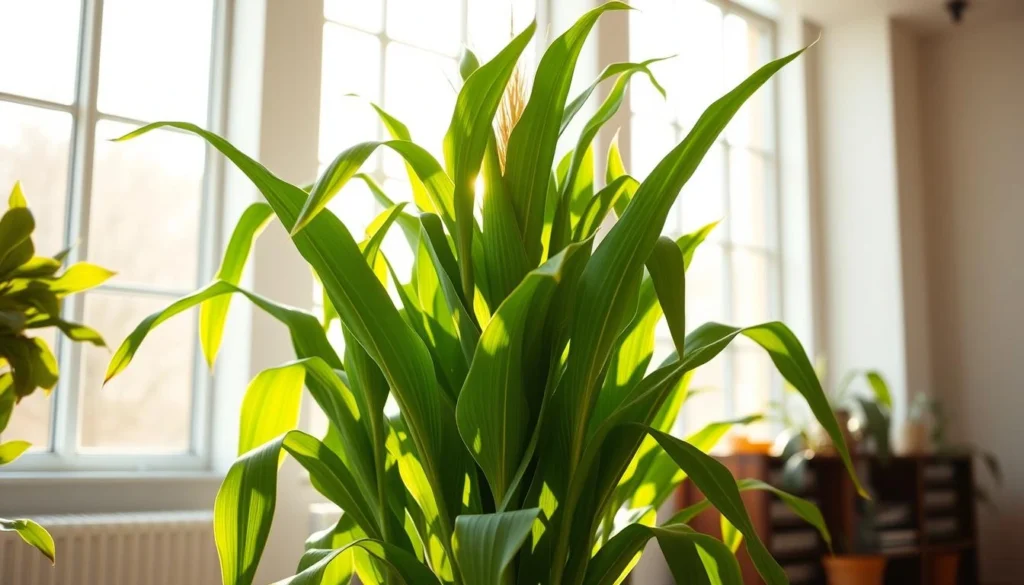
Temperature and Humidity Needs
Corn plants do best in temperatures between 60°F to 75°F (15°C to 24°C). They also need humidity levels of 40% to 50%. To keep humidity right, use a humidifier or a tray with water and pebbles.
Selecting the Right Pot and Soil Mix
A good potting mix is key for your corn plant’s health. Choose a pot that’s just a bit bigger than the plant’s roots. It should have holes for drainage.
Use a mix made for indoor plants. It should have peat moss and perlite to prevent waterlogged soil.
By following these tips, you can make a perfect home for your corn plant. It will become one of the best indoor plants corn plant lovers adore.
Essential Corn Plant Care Indoors
To keep your corn plant thriving indoors, it’s important to know its care needs. Corn plants are easy to care for and adapt well to indoor spaces. By following a few simple steps, you can keep your corn plant healthy and growing.
Watering Guidelines and Common Mistakes
Watering is key for corn plant care indoors. Water your plant sparingly, letting the soil dry a bit between waterings. Avoid overwatering, which can cause root rot and other problems.
To check if your plant needs water, stick your finger into the soil up to the first knuckle. If it’s dry, it’s time to water. Make sure your pot has drainage holes to prevent waterlogged soil.
Fertilizing Schedule and Requirements
Fertilizing your corn plant is vital during the growing season, which is spring and summer. Use a balanced, water-soluble fertilizer to give your plant the nutrients it needs.
| Season | Fertilizer Type | Frequency |
|---|---|---|
| Spring/Summer | Balanced, water-soluble | Every 2 weeks |
| Fall/Winter | No fertilization or reduced frequency | None or once a month |
Pruning Techniques for Healthy Growth
Pruning is essential to keep your corn plant healthy and looking good. It helps control the plant’s height and encourages new growth.
When and How to Prune
Prune your corn plant in the spring when it gets too tall or leggy. Remove any dead or damaged leaves to keep the plant looking its best and prevent disease.
Managing Height and Encouraging Branching
To encourage branching, cut back the top growth of your corn plant. This method, called “topping,” helps control the plant’s height and makes it fuller and bushier.
Propagating Your Corn Plant Successfully
To keep your corn plant indoor thriving, learning how to propagate it is key. Propagation is a great way to share your plant with others. It also lets you grow new plants for your home.
Stem Cutting Method
One way to propagate your corn plant is through stem cuttings. You’ll need a healthy stem section with at least two nodes. Cut it just below a node with a sharp tool, and remove lower leaves.
Place the cutting in water or a pot with a well-draining soil mix. Keep the soil moist and warm until roots appear.
Air Layering Technique
Another method for growing corn plant indoors is air layering. Make a small incision in the stem, just above a node. Wrap the area in moist sphagnum moss.
Secure the moss with twine or a plastic bag. Wait for roots to develop. Once they do, cut the stem below the new roots and pot the new plant.
Caring for New Corn Plant Babies
After propagating your corn plant, caring for the new plants is essential. Give them bright, indirect light. Keep the soil moist but not waterlogged.
Fertilize the new plants with a balanced fertilizer during the growing season. This promotes healthy growth.
Troubleshooting Common Corn Plant Problems
When you care for your indoor corn plant, you might face some common issues. These can be fixed with the right steps. Regular checks and proper care keep your plant healthy and growing well.
Identifying and Treating Pest Issues
Pests like spider mites, mealybugs, and scale can harm indoor corn plants. Look for these pests often to catch them early.
Spider Mites and Mealybugs
Spider mites and mealybugs are common pests. Spider mites turn leaves yellow or bronze, while mealybugs leave a sticky mess. To fight these pests, isolate your plant. Then, use insecticidal soap or neem oil to kill them.
Fixing Yellowing or Browning Leaves
Yellow or brown leaves can mean too much or too little water, or extreme temperatures. Check your watering and adjust it if needed. Make sure your plant gets bright, indirect light and stays in a temperature of 65-75°F (18-24°C).
Reviving an Overwatered or Underwatered Plant
Act fast if your corn plant is overwatered or underwatered. For an overwatered plant, stop watering and let the soil dry a bit. For an underwatered plant, water well and adjust your schedule to avoid future issues.
By using these tips and adjusting your care tips for corn plant, you can solve common problems. Keep your corn plant healthy and thriving indoors. Check your indoor corn plant care guide for more tips on keeping your plant in top shape.
Read More :
Indoor Bird of Paradise: Tips for Growing Success
Conclusion
Corn plants can do well indoors with the right care. They add beauty and benefits to your home. Follow the tips in this article to create a great space for your corn plant.
Good care means giving your corn plant the right light, water, and nutrients. Mastering these will make your plant healthy and vibrant. It will make your indoor space better.
Starting to care for your corn plant indoors takes patience and attention. With time, you’ll get better at it. Soon, you’ll have a beautiful and thriving plant in your home.
FAQ
How often should I water my corn plant indoors?
Check the soil’s moisture by feeling the top inch. Water once a week in summer and every 10-14 days in winter.
What is the ideal temperature for growing corn plants indoors?
Keep your corn plant in a spot with temperatures between 65-75°F (18-24°C) during the day. At night, it should not drop below 55°F (13°C).
Can I grow corn plants in low-light conditions?
Corn plants can handle low light but prefer bright, indirect light. Avoid direct sunlight to prevent leaf scorch. Place them near an east- or west-facing window.
How do I fertilize my corn plant?
Use a balanced, water-soluble fertilizer during spring and summer. Dilute it to half strength to protect the roots.
Why are my corn plant’s leaves turning yellow?
Yellow leaves might mean you’re watering too much or too little, or if the temperature is too extreme. Adjust your watering and keep your plant away from drafts and extreme temperatures.
Can I propagate corn plants using stem cuttings?
Yes, you can. Cut 4-6 inch stem sections with at least two nodes. Remove lower leaves and plant in moist potting mix. Keep it warm and humid until roots grow.
How do I prune my corn plant to maintain its shape?
Prune by removing dead or damaged leaves and cutting back tall stalks. Use clean, sharp tools to prevent disease spread.
Are corn plants toxic to pets?
Yes, corn plants are toxic to pets if eaten. They contain saponins, which can cause vomiting and diarrhea in cats and dogs. Keep them out of your pets’ reach.
